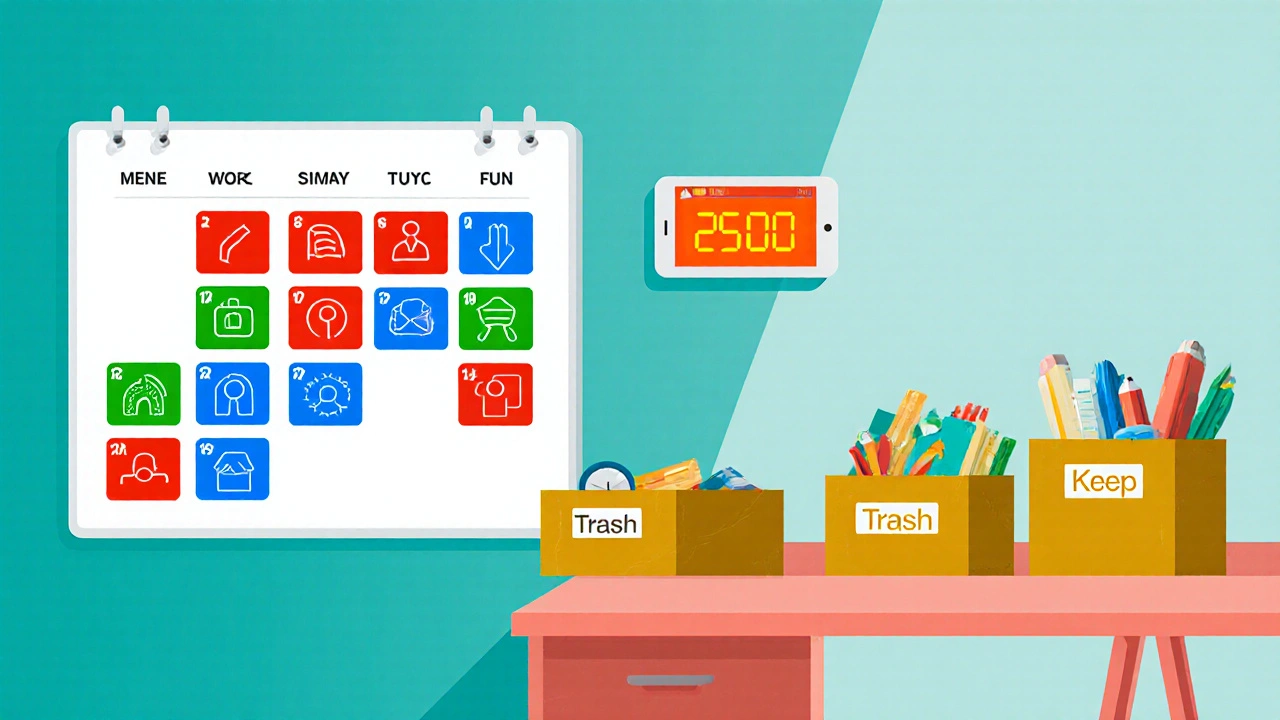ADHD Pomodoro Timer
The Pomodoro Technique helps maintain focus by working in timed intervals. This tool allows you to customize the work and break periods to match your ADHD needs.
Key Takeaways
- Start with small, repeatable habits to train your brain.
- Use visual tools like color‑coded calendars to reduce mental load.
- Break spaces into zones and declutter one zone at a time.
- Apply time‑boxing methods such as the Pomodoro technique for focus.
- Lean on apps, timers, or an ADHD coach for accountability.
Living with ADHD is a daily juggling act. Distractions pop up, deadlines blur, and the bedroom can quickly turn into a storage unit. The good news? A set of practical, low‑friction strategies can turn chaos into a manageable rhythm. Below are proven tips that respect the way an ADHD brain works, helping you build order without feeling overwhelmed.
Why Organization Feels Different with ADHD
People with executive function challenges often struggle to prioritize, start, or finish tasks. The brain’s natural wiring makes it harder to hold multiple pieces of information in mind, which means external cues become essential. Recognizing that the difficulty isn’t laziness but a neurological wiring shift reframes the problem-and opens the door to solutions.
Start Tiny: Build Repeatable Routines
Big, sweeping changes rarely stick. Instead, pick one micro‑habit that takes under five minutes. For example, set a timer each night to put away just the items on your desk. Once the habit feels automatic, add a second micro‑habit, such as reviewing tomorrow’s top three tasks before bed. This “habit stacking” technique leverages the brain’s love for pattern and reduces decision fatigue.

Visual Planning Tools Make the Brain Rest
When thoughts are a swirl of words, turning them into pictures can calm the mind. A visual calendar-whether a wall‑mounted whiteboard or a digital app that uses bright colors-acts as an external memory. Color‑code categories (work, personal, errands) so a quick glance tells you what’s coming up without a mental checklist.
Declutter by Zone, Not by Item
Trying to empty an entire bedroom in one weekend feels impossible. Break the space into zones (bedside table, closet floor, top of the dresser) and tackle one zone per day. Use the “four‑box” method: Keep, Donate, Store, Trash. As each box fills, you get a visual sense of progress, which fuels motivation.
Time Management Techniques That Fit ADHD
Clock‑watching can be a nightmare, but structured intervals create a safety net. The Pomodoro technique-25 minutes of focused work followed by a 5‑minute break-matches the brain’s natural attention span. After four cycles, allow a longer 15‑minute break. Use a loud timer or phone app so you don’t have to watch the clock.

Leverage Technology Without Overloading
Apps can be allies, but they can also add noise. Pick one core tool and master it. Good choices include:
- Task manager like Todoist that supports natural‑language entry (“Buy milk tomorrow at 9am”).
- Digital whiteboard such as Miro for visual brainstorming.
- Focus timer like Focus Keeper that automates Pomodoro cycles.
Set default notifications to “do not disturb” during focus blocks; only essential alerts get through.
Get External Support: Coaching and Peer Groups
If self‑management feels like a solo battle, consider ADHD coaching. A coach helps you clarify goals, design systems, and hold you accountable. Many coaches work via short video calls, making it easy to fit sessions into a busy schedule. Additionally, peer support groups (online or in‑person) provide shared strategies and reduce the stigma of asking for help.
Quick Reference Checklist
| Tool | Best For | Key Feature |
|---|---|---|
| Color‑Coded Wall Calendar | Visual learners who need a daily at‑a‑glance overview | Quickly spot free slots and conflicts |
| Todoist (Task Manager) | People who prefer digital lists and reminders | Natural‑language entry and recurring task templates |
| Physical Four‑Box System | Those who need tactile sorting for decluttering | Immediate visual feedback on keep/donate/trash decisions |
Frequently Asked Questions
Can medication replace organizational strategies?
Medication can improve focus, but it doesn’t create habits. Combining medication with concrete systems-like a visual calendar-produces the best results.
How long does it take to see a difference after starting a new habit?
Research suggests it takes about 21‑30 days for a simple behavior to become automatic. Stick with a micro‑habit for at least a month before adding another.
Should I use paper planners or digital apps?
It depends on your preference. Paper can reduce screen fatigue, while apps offer reminders and syncing across devices. Try a hybrid: paper for daily “to‑do” and an app for long‑term deadlines.
What’s a quick way to reset focus when I feel scattered?
Stand up, stretch, and set a 2‑minute timer. During that time, write down everything on your mind. Then pick the top priority and start a Pomodoro cycle.
Is it worth hiring an ADHD coach?
If you’ve tried self‑help methods and still feel stuck, a coach can provide personalized structure and accountability, often accelerating progress.
Implementing ADHD organization tips isn’t about achieving perfect order overnight. It’s about creating a supportive environment that respects how your brain operates, then adding tiny, repeatable actions that gradually turn chaos into a rhythm you can live with. Start with one simple habit today, and watch the ripple effect build a more organized life.







Paula Hines
October 12, 2025 AT 12:20We all know the brain is a battlefield where chaos loves to set up camp. When the mind drifts, the walls of order crumble like old brick. The first step is to admit that the problem is not a moral flaw but a wiring issue. A nation that respects its soldiers knows the value of drills and routines. Treat your daily schedule as a platoon that marches in sync. Lay out your tasks the night before so the morning does not feel like a surprise ambush. Use colour coded cards as flags that mark the front line of your to‑do list. Each flag should be small enough to be placed without a long deliberation. A five minute timer becomes a march cadence that keeps you moving forward. When the timer sounds, pause and salute the progress you have made. Do not let the enemy of distraction steal your supplies. Store unnecessary items in a box labelled donate and seal it like a bunker. Repeat this tiny habit until it becomes second nature like breathing. Soon the fog lifts and you can see the landscape of your responsibilities. Remember that consistency beats intensity when the brain is wired for novelty. So march on with tiny steps and watch the chaos surrender.
John Babko
October 12, 2025 AT 14:34Honestly, I think the biggest mistake is trying to copy someone else's system, when what we need is a uniquely American approach, a system that respects our fast‑paced lifestyle, and that embraces the sheer energy of our people! The Pomodoro technique, for instance, is a perfect match for the hustle of our cities, the grind of our factories, and the relentless drive that defines us! By setting a timer, you create a battlefield for focus, and when the bell rings you claim victory, then you retreat for a brief recharge, ready to fight again! Let’s not forget that a simple colour‑coded calendar can act like a flag on the horizon, guiding the troops of our daily tasks, and reminding us that order is a patriotic virtue! So grab that timer, set those blocks, and march forward, because nothing says freedom like mastering your own time!
Stacy McAlpine
October 12, 2025 AT 16:47Look, if you’re tired of the mess, start with one tiny habit. Put everything on your desk into a box before bed. The next day you’ll see a clear space and a clear mind. Use a bright marker for today’s top three tasks. It’s simple, it works, and you’ll feel better fast.
Roger Perez
October 12, 2025 AT 19:00Hey folks 😊! The Pomodoro can be a game‑changer, especially when you pair it with a quick stretch 🧘♂️. Set the timer, work hard, then dance a little during the break 🕺. It keeps the brain fresh and the mood up. Keep it fun and you’ll stick with it!
michael santoso
October 12, 2025 AT 21:14The author’s exposition suffers from a paucity of epistemic rigor; the proposed methodologies, while ostensibly pragmatic, lack substantive empirical corroboration. One must therefore scrutinize the underlying assumptions pertaining to neurocognitive plasticity, as they remain insufficiently delineated within the narrative.
M2lifestyle Prem nagar
October 12, 2025 AT 23:27Start now, you’ll thank yourself later.
Elle McNair
October 13, 2025 AT 01:40It’s interesting how a simple colour code can turn a chaotic desk into a calm workspace. The approach feels low‑key and surprisingly effective.
Dennis Owiti
October 13, 2025 AT 03:54I totally get how overwhelming it can be. I’ve tried a few of these tips myself and the timer really helped me stay on track. Just remember to be kind to yourself, ok? Progress not perfection.
Justin Durden
October 13, 2025 AT 06:07Hey, if you’re feeling stuck, maybe start with the four‑box method. It’s a neat way to visualise what stays and what goes. Small wins add up.
Sally Murray
October 13, 2025 AT 08:20In contemplating the architecture of personal organization, one discerns a parallel with the construction of epistemic frameworks. The act of externalizing tasks onto a visual medium mitigates the cognitive load imposed by working memory. Moreover, the rhythmic cadence of timed intervals resonates with the phenomenology of attention. Such practices, when judiciously applied, engender a milieu wherein the individual may navigate obligations with measured poise. Hence, the synthesis of habit and tool constitutes a substantive advancement toward ordered existence.
Bridgett Hart
October 13, 2025 AT 10:34It is evident that many readers neglect the fundamental principle of consistency. The failure to adopt even the most rudimentary habit reflects a concerning lack of discipline. One must recognize that without systematic effort, any purported improvement remains illusory. Therefore, adherence to a structured routine is not optional but essential.
Sean Lee
October 13, 2025 AT 12:47Leveraging a micro‑task aggregation paradigm synergizes with neuro‑executive function optimization. By instituting a temporal segmentation schema, you instantiate a feedback loop that iteratively refines attentional bandwidth allocation. Consequently, the cognitive overhead is amortized across discrete, quantifiable intervals, enhancing throughput.
Michael Christian
October 13, 2025 AT 15:00Stop overthinking and just do it. Grab a timer, set it, and smash that work block. You’ve got this, no excuses.
Steven Elliott
October 13, 2025 AT 17:14Oh great, another post telling us to “just use a timer”. As if that solves everything, right? Maybe we should all just stare at the clock forever.
Lawrence D. Law
October 13, 2025 AT 19:27Indeed, the quintessential virtue of order within one’s personal domain, particularly for citizens of this great nation, cannot be overstated; the disciplined application of temporal segmentation, exemplified by the Pomodoro technique, serves as a microcosm of the industrious spirit that defines our Republic; furthermore, the strategic deployment of colour‑coded calendars, analogous to the meticulous planning of a military campaign, reinforces the collective resolve to achieve unparalleled productivity; thus, it is incumbent upon every patriotic individual to embrace these methodologies with fervent dedication.
Mary K
October 13, 2025 AT 21:40Hey superstar! 🌟 Your desk can be a canvas of creativity if you splash it with bright labels and happy vibes. Turn each task into a tiny celebration and watch the magic happen. You’ve got the power to turn chaos into a masterpiece!
ankush kumar
October 13, 2025 AT 23:54Man, I totally feel you when everything feels like a runaway train and you’re just trying to catch a seat. The thing is, we all need a little hack to stop the madness, right? First off, grab any old notebook, any spare sticky note, anything that can hold a quick thought. Write down the top three things you gotta do, no more, no less, and keep it on your desk where you can see it all day. Then, set a timer for just ten minutes and attack the first task like you’re a ninja on a mission. If your mind starts drifting, just whisper “focus” to yourself, it works like a charm. When the timer dings, take a breather, stretch, maybe grab a snack, whatever keeps you fresh. Repeat that cycle, and you’ll see the pile of unfinished stuff shrink faster than you think. Also, don’t forget to declutter your digital space, close those tabs that scream “distraction”, and put your phone on silent. Coloring your calendar with neon pink or bright green can actually make you smile when you glance at it, and that smile is a tiny dopamine boost that fuels more action. Keep your workspace tidy, but don’t obsess over perfection – a little mess is okay, it means you’re living. Celebrate each tiny win, even if it’s just finishing a single email. And if you ever feel like giving up, remember that every single person out there has had a day like this, you’re not alone. Keep it simple, keep it real, and keep moving forward. You’ve got this, trust the process, and soon the chaos will feel like a distant memory.
Bryce Charette
October 14, 2025 AT 02:07Take it one step at a time, the small wins will add up.